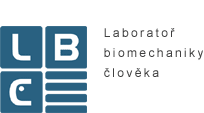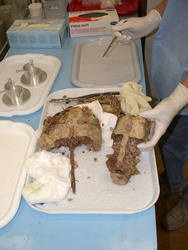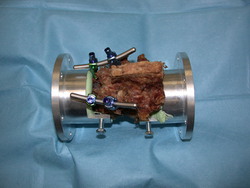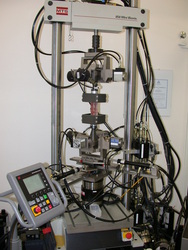
Musculoskeletal system and artificial replacements
Experimental measurement of the lumbar spine kinematics
Project description:
The lumbar instability is a common disease in clinical practice. Degenerative changes in the intervertebral disc are always accompanied with the osteophyte formation on the margins of the vertebral bodies and remodelling changes in the apophyseal joints. There is a direct relationship between the degree of disc degeneration, marginal osteophyte formation on vertebral bodies and apophyseal joint changes, which suggests that disc degeneration is the primary event leading to the clinical condition called ,,degenerative spondylosis”. There are two surgical methods of treatment of the disc degeneration (when replacing intervertebral disc): spinal fusion and artificial disc replacement. The disadvantage of the fusion is decreasing of mobility depending on the increasing of adjacent vertebrae and discs load. Furthermore, none of currently available artificial intervertebral discs does respect all properties of natural disc (no shock absorption, no bending and torsion stiffness). Therefore , surgeons have come with a demand to develop a new artificial disc replacement, which will respect all physiological properties of intervertebral disc. The outputs of presented experimental measurement were used as an input data for design a new type artificial disc replacement developed in the Laboratory of biomechanics. The purpose of the presented study is an experimental measurement of the lumbar spine kinematics and stiffness. The cadaveric pig lumbar spine consisting of three vertebrae and two intervertebral discs was used for the verification of this experimetal method. Specimen was surgically modificated (spinal fixator) and fixed to the testing machine MTS 858. 2 Mini bionix, which is equipped with the special spinal simulator with 8 degrees of freedom (3 translation, 5 rotation). The fixed spine was loaded by the bending moment 1,5 Nm in flexion, extension, lateral bendind and axial rotation. Application of load was static without inertial forces. Experimental measurements play the main role in biomechanical research.
doc. Ing. Radek Sedláček, Ph.D. ; Petr Tichý Ph.D.Resesrchers:
FH Plzen, MUDr, David Bludovsky
Cooperation:
Literature:
- L. Jirková, Z. Horák, P. Tichý, R. Sedláček: Experimental Measurements of the Lumbar Spine Stiffness and Range of Motion, 4th Youth Symposium on Experimental Solid Mechanics, Bologna, 2005
- L. Jirková, Z. Horák, P. Tichý, R. Sedláček, J. Michalec: Experimental Measurement of the Lumbar Spine Kinematics and Stiffness, 5th International Conference on Mechanics and Materials in Design, Porto, 2006
- L. Jirková, Z. Horák, P. Tichý, R. Sedláček, J. Michalec: Comparison of surgical techniques influence on the lumbar spine stiffness, The 6th Youth Symposium on Experimental Solid Mechanics, Kraljevo, 2007
- L. Jirková, Z. Horák, P. Tichý, R. Sedláček, J. Michalec: Preliminary measurements of lumbar spine kinematics and stiffness, Fifth Australasian Congress on Applied Mechanics, Brisbane, 2008




